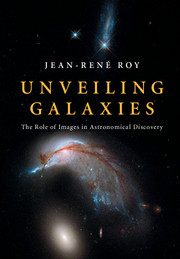Refine listing
Actions for selected content:
17002 results
Part II - Images as Galaxy Discovery Engines
-
- Book:
- Unveiling Galaxies
- Published online:
- 06 October 2017
- Print publication:
- 12 October 2017, pp 92-102
-
- Chapter
- Export citation
Part III - Organizing the World of Galaxies
-
- Book:
- Unveiling Galaxies
- Published online:
- 06 October 2017
- Print publication:
- 12 October 2017, pp 173-184
-
- Chapter
- Export citation
Index
-
- Book:
- Unveiling Galaxies
- Published online:
- 06 October 2017
- Print publication:
- 12 October 2017, pp 257-269
-
- Chapter
- Export citation
8 - Imaging the Invisible
- from Part II - Images as Galaxy Discovery Engines
-
- Book:
- Unveiling Galaxies
- Published online:
- 06 October 2017
- Print publication:
- 12 October 2017, pp 150-172
-
- Chapter
- Export citation
Dedication
-
- Book:
- Unveiling Galaxies
- Published online:
- 06 October 2017
- Print publication:
- 12 October 2017, pp i-iv
-
- Chapter
- Export citation
Preface
-
- Book:
- Unveiling Galaxies
- Published online:
- 06 October 2017
- Print publication:
- 12 October 2017, pp vii-viii
-
- Chapter
- Export citation
6 - Galaxies in Focus
- from Part II - Images as Galaxy Discovery Engines
-
- Book:
- Unveiling Galaxies
- Published online:
- 06 October 2017
- Print publication:
- 12 October 2017, pp 105-130
-
- Chapter
- Export citation
Part I - Images and the Cosmos
-
- Book:
- Unveiling Galaxies
- Published online:
- 06 October 2017
- Print publication:
- 12 October 2017, pp 1-14
-
- Chapter
- Export citation
Reviews
-
- Book:
- Unveiling Galaxies
- Published online:
- 06 October 2017
- Print publication:
- 12 October 2017, pp i-iv
-
- Chapter
- Export citation
Bibliography
-
- Book:
- Unveiling Galaxies
- Published online:
- 06 October 2017
- Print publication:
- 12 October 2017, pp 253-256
-
- Chapter
- Export citation
10 - Atlases of Galaxies, Picturing “Island-Universes”
- from Part III - Organizing the World of Galaxies
-
- Book:
- Unveiling Galaxies
- Published online:
- 06 October 2017
- Print publication:
- 12 October 2017, pp 187-204
-
- Chapter
- Export citation
4 - Portraying “Nebulae” for the Mind
- from Part I - Images and the Cosmos
-
- Book:
- Unveiling Galaxies
- Published online:
- 06 October 2017
- Print publication:
- 12 October 2017, pp 59-91
-
- Chapter
- Export citation
3 - From Celestial Snapshots to Photographing the Realm of Galaxies
- from Part I - Images and the Cosmos
-
- Book:
- Unveiling Galaxies
- Published online:
- 06 October 2017
- Print publication:
- 12 October 2017, pp 34-58
-
- Chapter
- Export citation

Unveiling Galaxies
- The Role of Images in Astronomical Discovery
-
- Published online:
- 06 October 2017
- Print publication:
- 12 October 2017
Frontmatter
-
- Book:
- Data Analysis Techniques for Physical Scientists
- Published online:
- 24 October 2017
- Print publication:
- 05 October 2017, pp i-iv
-
- Chapter
-
- You have access
- Open access
- Export citation
How to Read This Book
-
- Book:
- Data Analysis Techniques for Physical Scientists
- Published online:
- 24 October 2017
- Print publication:
- 05 October 2017, pp xiii-xiv
-
- Chapter
-
- You have access
- Open access
- Export citation
Part I - Foundation in Probability and Statistics
-
- Book:
- Data Analysis Techniques for Physical Scientists
- Published online:
- 24 October 2017
- Print publication:
- 05 October 2017, pp 15-16
-
- Chapter
-
- You have access
- Open access
- Export citation
14 - Collision and Detector Modeling
- from Part III - Simulation Techniques
-
- Book:
- Data Analysis Techniques for Physical Scientists
- Published online:
- 24 October 2017
- Print publication:
- 05 October 2017, pp 663-686
-
- Chapter
-
- You have access
- Open access
- Export citation
References
-
- Book:
- Data Analysis Techniques for Physical Scientists
- Published online:
- 24 October 2017
- Print publication:
- 05 October 2017, pp 687-697
-
- Chapter
-
- You have access
- Open access
- Export citation
Index
-
- Book:
- Data Analysis Techniques for Physical Scientists
- Published online:
- 24 October 2017
- Print publication:
- 05 October 2017, pp 698-704
-
- Chapter
-
- You have access
- Open access
- Export citation
